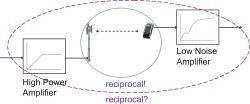Channel Reciprocity in TDD
To meet the requirements of future mobile communication system concerning high data rate and Quality of Service (QoS) the utilization of adaptive transmit strategies is crucial. Therefore, the smart exploitation and distribution of time, frequency and space resources is an important topic in today's research and standardization activities. The optimization of developed algorithms is strongly dependent on the degree of channel state information (CSI) at the transmitter. A possibility to achieve CSI is the transmission of existing information from the receiver to the transmitter via a feedback channel. However, this causes a degradation of the overall system throughput. Especially in multi-antenna (MIMO) and multi-carrier (e.g. OFDM) systems the amount of necessary feedback to signalize the CSI dramatically increases with the number of antennas and subcarriers. Hence, more efficient approaches to gain CSI at the transmitter are of great interest.
In general, both transmit directions in wireless communication systems are separated via time or frequency duplexing. In Time Division Duplex (TDD) mode the same physical transmission channel is existent for the Forward Link (considered transmission from the transmitter to the receiver) and the Reverse Link (transmission to the transmitter). The question arises how its physical equivalence can be profitably exploited to obtain CSI at the transmitter. If the so-called reciprocity is met, forward and reverse link match such that the estimated channel at the transmitter can directly be used for adaptive signal processing algorithms. As the circuitry components at the transmitter and receiver front-ends differ, the assumed reciprocity of the physical channel cannot be adopted at the interfaces to the digital baseband. Nevertheless, to achieve a preferably good Link Equivalence (similarity of the transfer functions of forward and reverse link) e.g. the calibration of the front-ends by using additional or modified circuitries or signal processing algorithms is conceivable.
 |
Comments